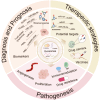Recent Progress of Exosomes in Hematological Malignancies: Pathogenesis, Diagnosis, and Therapeutic Strategies
- PMID: 39539968
- PMCID: PMC11559222
- DOI: 10.2147/IJN.S479697
Recent Progress of Exosomes in Hematological Malignancies: Pathogenesis, Diagnosis, and Therapeutic Strategies
Abstract
Hematological malignancies originate from the hematopoietic system, including lymphoma, multiple myeloma, leukaemia, etc. They are highly malignant with a high incidence, a poor prognosis and a high mortality. Although the novel therapeutic strategies have partly improved the clinical efficacy of hematological malignancies, patients still face up with drug resistance, refractory disease and disease relapse. Many studies have shown that exosomes play an important role in hematological malignancies. Exosomes are nanoscale vesicles secreted by cells with a size ranging from 40 to 160 nm. They contain various intracellular components such as membrane proteins, lipids, and nucleic acids. These nanoscale vesicles transmit information between cells with the cargos. Thus, they participate in a variety of pathological processes such as angiogenesis, proliferation, metastasis, immunomodulation and drug resistance, which results in important role in the pathogenesis and progression of hematological malignancies. Furthermore, exosomes and the components carried in them can be used as potential biomarkers for the diagnosis, therapeutic sensitivity and prognosis in hematological malignancies. In the therapy of hematologic malignancies, certain exosome are potential to be used as therapeutic targets, meanwhile, exosomes are suitable drug carriers with lipid bilayer membrane and the nanostructure. Moreover, the tumor-derived exosomes of patients with hematologic malignancies can be developed into anti-tumor vaccines. The research and application of exosomes in hematological malignancies are summarized and discussed in this review.
Keywords: biomarkers; drug carriers; exosomes; hematological malignancies; targets; vaccines.
© 2024 Zhang et al.
Conflict of interest statement
The authors report no conflicts of interest in this work.
Figures




Similar articles
-
Emerging role of exosomes in hematological malignancies.Clin Exp Med. 2023 Aug;23(4):1123-1136. doi: 10.1007/s10238-022-00850-z. Epub 2022 Jul 7. Clin Exp Med. 2023. PMID: 35798882 Review.
-
Harnessing the power of exosomes for diagnosis, prognosis, and treatment of hematological malignancies.Stem Cell Res Ther. 2025 Jan 7;16(1):6. doi: 10.1186/s13287-024-04125-0. Stem Cell Res Ther. 2025. PMID: 39773361 Free PMC article. Review.
-
The emerging roles of tumor-derived exosomes in hematological malignancies.Leukemia. 2017 Jun;31(6):1259-1268. doi: 10.1038/leu.2017.91. Epub 2017 Mar 21. Leukemia. 2017. PMID: 28321122 Review.
-
Exosomal microRNA panels as biomarkers for hematological malignancies.Curr Probl Cancer. 2021 Oct;45(5):100726. doi: 10.1016/j.currproblcancer.2021.100726. Epub 2021 Mar 5. Curr Probl Cancer. 2021. PMID: 33752898 Review.
-
Research progress on exosomes derived from mesenchymal stem cells in hematological malignancies.Hematol Oncol. 2021 Apr;39(2):162-169. doi: 10.1002/hon.2793. Epub 2020 Sep 1. Hematol Oncol. 2021. PMID: 32869900 Free PMC article. Review.
References
Publication types
MeSH terms
Substances
LinkOut - more resources
Full Text Sources

